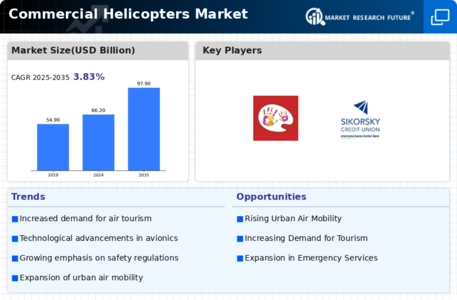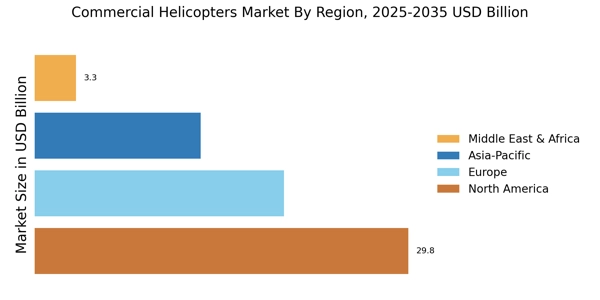Increased Focus on Safety Regulations
Increased focus on safety regulations is a significant driver in the Commercial Helicopters Market. Regulatory bodies are continuously updating safety standards to enhance operational safety for helicopter operations. This heightened emphasis on safety is prompting manufacturers to invest in advanced safety features and technologies, such as collision avoidance systems and enhanced pilot training programs. The market is witnessing a trend where operators are prioritizing compliance with stringent safety regulations, which in turn drives demand for newer, safer helicopter models. As safety becomes a paramount concern for both operators and passengers, the Commercial Helicopters Market is likely to see a shift towards helicopters that meet or exceed these evolving safety standards.
Expansion of Tourism and Leisure Activities
The expansion of tourism and leisure activities is significantly influencing the Commercial Helicopters Market. Helicopter tours have become increasingly popular in various regions, offering unique aerial views of landscapes and urban environments. The tourism sector is projected to grow, with helicopter tourism expected to contribute substantially to this growth. In 2025, the helicopter tourism market is estimated to reach around 1.2 billion USD, driven by the rising disposable incomes and a growing appetite for adventure experiences among travelers. This trend encourages helicopter operators to invest in modern fleets that enhance passenger comfort and safety. Thus, the Commercial Helicopters Market is poised to benefit from the burgeoning demand for helicopter services in the tourism sector.
Rising Demand for Emergency Medical Services
The increasing need for rapid emergency medical services is a pivotal driver in the Commercial Helicopters Market. Helicopters are often the fastest means of transport for critically ill patients, especially in remote areas. The demand for air ambulances has surged, with the market for air medical services projected to reach approximately 5 billion USD by 2026. This growth is attributed to the rising incidences of accidents and health emergencies, necessitating swift medical intervention. Consequently, helicopter manufacturers are focusing on developing specialized aircraft that cater to the unique requirements of medical transport, thereby enhancing their operational capabilities. As a result, the Commercial Helicopters Market is likely to witness a significant uptick in demand for helicopters designed for emergency medical services.
Technological Innovations in Helicopter Design
Technological innovations in helicopter design are significantly influencing the Commercial Helicopters Market. Advancements in materials, aerodynamics, and avionics are leading to the development of more efficient and safer helicopters. For instance, the introduction of composite materials has reduced weight while enhancing structural integrity, which is crucial for performance. Additionally, innovations in rotor technology are improving fuel efficiency and reducing noise levels, making helicopters more appealing for urban operations. The market is witnessing a shift towards electric and hybrid helicopters, which are expected to play a vital role in the future of aviation. These technological advancements are likely to attract new investments and expand the operational capabilities of helicopters in the Commercial Helicopters Market.
Government Investments in Infrastructure Development
Government investments in infrastructure development are playing a crucial role in shaping the Commercial Helicopters Market. Many governments are recognizing the strategic importance of helicopters for transportation, especially in regions with challenging terrains. Investments in heliports and related infrastructure are expected to increase, facilitating the growth of helicopter operations. For instance, several countries have initiated projects to enhance their air transport networks, which includes the establishment of dedicated helicopter landing zones. This infrastructure development is anticipated to bolster the operational efficiency of helicopter services, thereby driving demand in the Commercial Helicopters Market. As a result, the market is likely to experience a positive impact from these governmental initiatives.


















Leave a Comment